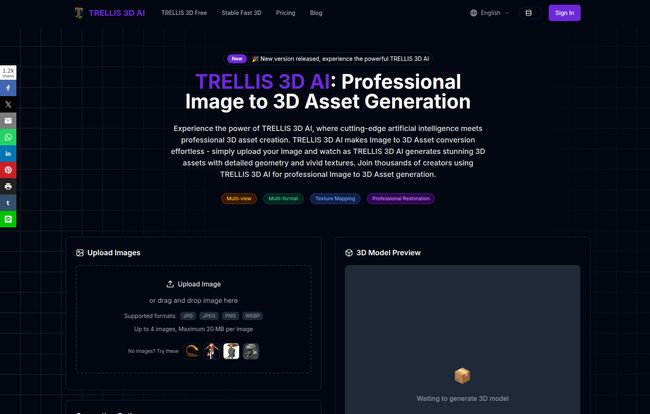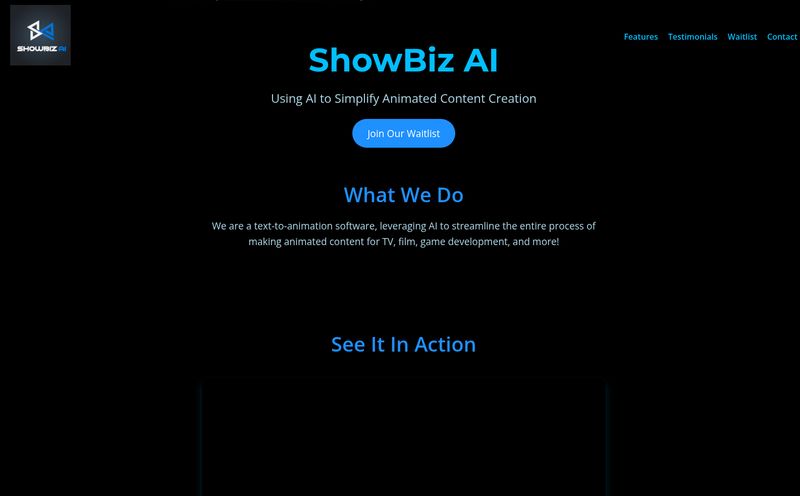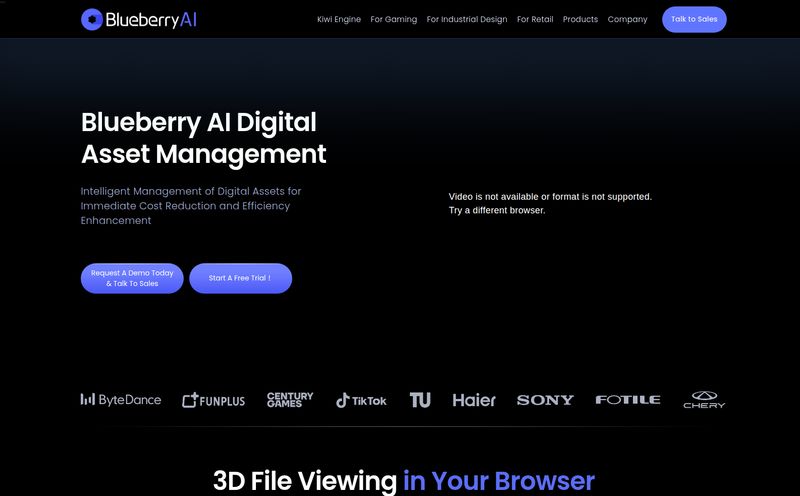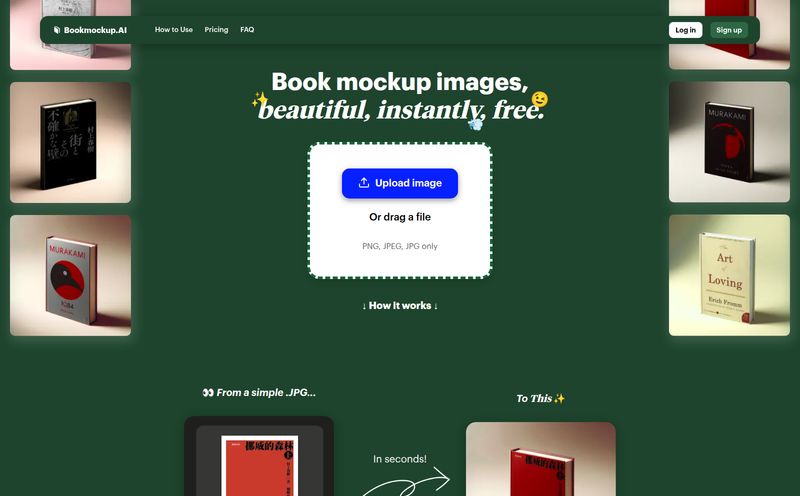If you're like me, you've been riding the absolute tsunami of AI tools that have washed over the internet in the last couple of years. Every week there's a new 'game-changer'. Some are genuinely impressive, others are... well, they’re neat for about five minutes. So when I heard about TRELLIS 3D AI, a tool that claims to turn any 2D image into a professional 3D asset, my professional skepticism kicked in. But my inner tech nerd was also doing a little dance. I mean, who hasn't wanted to just point at a picture and say, "Computer, make that 3D"?
I’ve spent years generating traffic, analyzing trends, and getting my hands dirty with every new piece of tech that promises to make a creator's life easier. So I took TRELLIS 3D for a spin to see if it lives up to the hype or if it's just another flash in the pan. Here’s the no-fluff breakdown.
So, What Exactly is TRELLIS 3D AI?
In a nutshell, TRELLIS 3D AI is a web-based platform that does one thing, but aims to do it exceptionally well: it transforms your static, flat, 2D images into fully-fledged 3D models. Think of it like a ridiculously smart digital sculptor. You give it a photo of a coffee mug, a cool statue you saw, or even a character drawing, and its AI brain gets to work.
The tech behind the curtain is pretty sophisticated. They toss around terms like Structured LATents (SLAT) and vision encoders. In human speak, this means the AI isn’t just 'guessing' what the back of the object looks like. It’s building an actual understanding of the object's geometry and structure. This is what separates it from some of the older, jankier methods that would often produce lumpy, unrecognizable blobs. This thing tries to create an asset with real structural integrity and surprisingly vivid textures.
Getting Started: The First-Click Experience
The first thing that struck me was the simplicity. The user interface is clean. Almost... suspiciously clean. There's no clutter, no confusing menus, just a big friendly 'Upload Image' box. You can drag and drop a file, pick one, or even use one of their examples. It feels less like operating complex software and more like using a simple file converter.

Visit TRELLIS 3D AI
You upload your pic, select a detail level (Normal or Professional), choose an output format, and hit the big purple button. That's it. They claim 'instant processing,' and while it’s not literally a snap of the fingers, it’s impressively fast. We’re talking seconds or a minute, not hours of rendering. For anyone who’s ever waited for a 3D render to finish, you know this is a kind of magic.
The Output: Did My JPEGs Become Digital Masterpieces?
This is the moment of truth, right? And I gotta say, I was pleasantly surprised. The quality is a huge step up from what I expected. The models have detailed textures (thanks to PBR texture support) and the geometry is solid. I tested it with a few different images—a simple product shot, a more complex decorative item, and a cartoon character.
The results directly depend on the quality of your input image, which is just common sense. A clear, well-lit photo from the front will yield a much better result than a blurry, angled shot from your ten-year-old flip phone. But when you give it good material, it delivers. The ability to export in formats like GLB is fantastic for web developers, AR/VR creators, and anyone using platforms like Shopify for 3D product viewers. The inclusion of 3D Gaussian formats also shows they're thinking ahead, catering to the latest in high-fidelity rendering techniques.
Key Features That Actually Matter
Lots of tools have long feature lists, but only a few things really impact your workflow. Here's what stood out to me.
The In-Browser Preview and Editing
Before you even download the file, you get a fully interactive 3D preview right in your browser. You can spin the model around, check it from all angles, and make sure it captured the essence of your image. They also mention 'local editing capability,' which is a huge plus. It means you're not just stuck with the initial AI generation; you can take the asset into your preferred 3D software (like Blender or Cinema 4D) and refine it. It’s not a one-and-done black box, it's a starting point—a very, very good starting point.
Advanced Generation Models
The platform offers different model settings, like 'Professional', which suggests a more resource-intensive but higher-quality generation. This is a smart move. Sometimes you just need a quick-and-dirty asset for a mockup. Other times, you need the best possible quality for a final product. Having that choice is a sign of a tool built for actual professionals, not just hobbyists.
The Million-Dollar Question: TRELLIS 3D AI Pricing
Okay, the homepage says it's a 'free AI tool,' and it is... to an extent. There's a free tier that lets you play around and get a feel for it, which I always appreciate. But for serious, repeated use, you'll be looking at their paid plans. It's a classic freemium model, and frankly, it’s a fair one.
They operate on a credit system. Here's how it breaks down (based on annual billing, which gives a discount):
| Plan | Price (Billed Annually) | Credits per Month | Best For |
|---|---|---|---|
| Basic | $8 / month | 300 | Hobbyists or those with occasional needs. |
| Plus | $16 / month | 1000 | Freelancers, indie developers, and regular creators. |
| Pro | $48 / month | 4000 | Studios, agencies, and power users. |
A crucial thing to know: credits expire. If you don't use your monthly credits, they don't roll over. It’s a bit of a 'use it or lose it' situation. While I’m not a huge fan of this model personally, it's pretty common in the SaaS world. The paid tiers also unlock some key features like asset privacy (so your models aren't shared in a public gallery) and priority support.
Who Is This Tool Really Built For?
After playing with it, I can see a few groups getting a ton of value from TRELLIS 3D.
- Indie Game Developers: Need to populate a world with hundreds of assets? This is an incredible way to generate high-quality placeholders or even final assets for props and environmental objects.
- AR/VR Creators: Building augmented reality experiences requires a library of 3D objects. This tool drastically lowers the barrier to entry.
- E-commerce Store Owners: Imagine turning your standard product photos into interactive 3D models for your website. That’s a powerful way to increase engagement and sales.
- 3D Artists & Designers: Use it as a powerful concepting tool. Quickly turn a sketch or reference image into a 3D base mesh that you can then refine and detail. It's a massive time-saver.
FAQs About TRELLIS 3D AI
What makes TRELLIS 3D AI different from other 3D generators?
From my experience, its main strengths are the quality of the geometry and textures, thanks to its SLAT-based AI, and its sheer speed and ease of use. It feels more polished and production-ready than many competitors.
Can I actually use TRELLIS 3D for free?
Yes, you can. There is a free version that lets you convert images. However, for advanced features, higher generation limits, and things like asset privacy, you will need to subscribe to one of teh paid plans.
Are the 3D assets good enough for commercial projects?
Absolutely. The output is clean, and with formats like GLB, the models are ready for commercial applications in games, web, and AR. As always, you might want to do some minor clean-up in a dedicated 3D program for high-end use cases.
What’s the deal with the credits? Do they roll over?
No, they do not. The credits are allotted monthly and expire at the end of your billing cycle. It's important to choose a plan that matches your expected usage to avoid losing them.
What file formats can I download my models in?
The primary formats are GLB, which is a standard for web and real-time applications, and 3D Gaussian for more advanced rendering. The availability might depend on your subscription plan.
How important is the input image quality?
Very. Garbage in, garbage out. A clear, well-lit, front-facing image will give you the best results. The AI is smart, but it’s not a mind reader. Give it good data to work with.
My Final Verdict: Is TRELLIS 3D AI Worth Your Time?
Yes. A resounding yes.
TRELLIS 3D AI sits in that sweet spot between being incredibly powerful and surprisingly accessible. It’s not just a novelty AI toy; it’s a genuinely useful tool that can slot right into a professional creative workflow and save a staggering amount of time and effort. Turning a 2D image into a usable 3D asset used to be a skilled, multi-hour process. Now, it's the work of a lunch break.
While the credit system requires some thought, the value proposition is undeniable. Whether you're a seasoned 3D pro looking to speed up your workflow or a complete beginner who wants to start creating in 3D, TRELLIS 3D AI is one of those tools you should absolutely bookmark. It’s a testament to how far AI has come, and a very exciting glimpse of where creative technology is headed.



